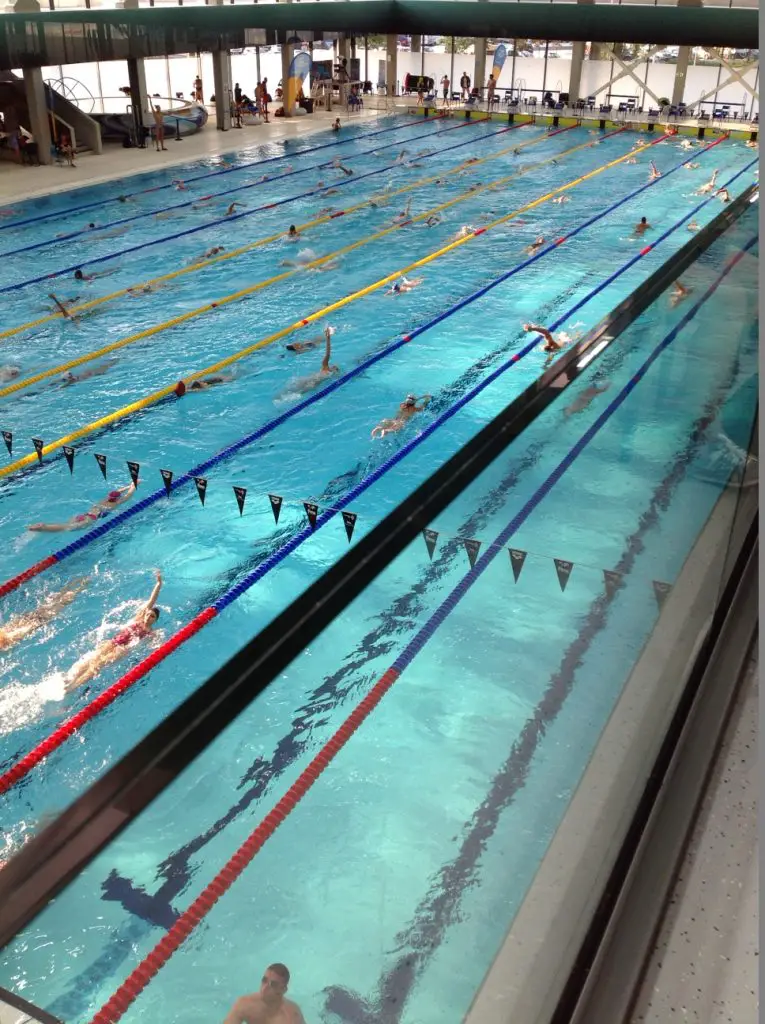Have you ever found yourself swimming laps in a lane, minding your own business when someone runs into you? Chances are that they – or you! – weren’t following proper swim etiquette.
When swimming, it’s important to follow common lap swimming rules to help keep you and other safe. And while you might get lucky with your own lane, chances are you’ll have to share eventually.
Luckily, learning and understanding lap swim etiquette is easy! Here are some common pool etiquette rules for sharing a lane with other swimmers.
Please note that these swim etiquette rules are for non-competitive swimmers. If you’re wanting to join a swim team (or have just joined one) be sure to check out our other article: Swim Practice Etiquette for more swim etiquette to follow.
Disclosure: This post may contain affiliate links, meaning we earn a small commission at no cost to you if you purchase something through one of our links. As an Amazon Associate, we earn from qualifying purchases. Please check out our disclosure page for more information.

What is Swim Etiquette?
Swim etiquette, in short, is the rules and unspoken agreements to swim with others in a generous manner. This ensures the safety and sanity for yourself and other swimmers! 🙂
While most of these rules are universal, we will put a standard disclaimer that some rules vary by location and team.
Pool Etiquette 101: 15 Ways to Share the Pool With Other Swimmers
1. Look for the Least Crowded Lane
When possible, try to find an empty lane first.
Swimmers love having a lane to themselves! Joining a lane with another swimmer when there’s an open lane is a sure way to annoy someone. Chances are, they’ll gather their equipment and move to the empty lane instead if one is available.
2. Pick Your Lane Based Off Your Speed
If you don’t have any empty lanes available, find a lane that fits your speed. This will require you to be honest with yourself, but your fellow lane mates will appreciate it.
Getting into a lane that’s too fast or slow for you will only make you and others frustrated. You’ll either find yourself being run over by faster swimmers. Or constantly trying to pass other swimmers.
Take a moment to judge the speed of the lane before joining or finding a new lane. If you join a lane and realize it’s not your speed, be gracious when you leave.
3. Know the Direction of the Lane
Now that you’ve found your lane, take another minute to determine what direction the lane is swimming in. Your lane will swim in one of the below methods:
- Circle Swimming: Form of lap swim etiquette where you swim in a counterclockwise circle. You swim down the right-hand side of the lane, complete a flip turn, and return on the right-hand side of the lane. In that, you always keep the lane line to your right side (left when on your back). Typically used when more than one swimmer is in the lane.
- Reverse Circle Swimming: Swimming etiquette where you swim clockwise. Swimmers swim down the left-hand side of the lane, complete a flip turn, and return on the left side of the lane. In that, you always keep the lane line to your left side (right side on your back). Typically used when more than one swimmer is in the lane.
- Side Swimming: When two swimmers agree to split the lane. Each swimmer will pick a side of the lane and so that they go down the right side and come back on the left. Or vice versa.
Some facilities will have diagrams to show which direction the lane needs to follow for lap swim.
Most teams and swim facilities in the US follow ‘circle swimming’. However, you might find some locations will alternate lanes with circle swimming and reverse circle swimming.
Related post: Basic Swimming Terminology
Because of this, it’s important to know what direction your lane swims in. Don’t assume!

4. Check in With Other Swimmers
Before you enter the water, you should let the other swimmers in the lane know that you’re joining them.
You can do this by:
- Waiting on the deck until someone stops and joining then
- Sticking your legs in the water at the wall so approaching swimmers notice you
- Enter the water and stand near the corner so current swimmers can see you
When you join a lane with just one other swimmer, don’t assume that you’ll split the lane. Always clarify with your new lane mate before splitting the lane.
More Content for You: How to Make Your Swimsuit Last Longer
If you plan to join a lane with just two swimmers who already split the lane, be sure they know you’ve joined. Usually, someone will stop and clarify the direction of the lane with you and then notify the other swimmer.
5. Don’t Jump on People
This probably sounds silly to say, but we say it because swimmers have done it before!
Check the water before jumping in. When entering the pool, you’ll want to ensure that no one is right where you’re about to jump or dive in.
Jumping on someone doesn’t just hurt. It’s also incredibly dangerous.
6. Don’t Follow the Black Tiled Line
It’s tempting to swim down the middle of the lane and follow the black line. But doing this will only lead to you running into other swimmers who are also in the lane.
Remember that when you’re lap swimming you always want to ensure that you’re swimming just to the side of the black line. In that, you’re circling around the black line. See what we did there? 😉
The only time you can swim straight down the black line is when you have the lane to yourself. If someone joins your lane though, you’ll need to decide which direction the lane will swim in.
7. Avoid Cutting Off Other Swimmers
If someone is coming down the lane and is five seconds from turning, don’t push off in front of them! Don’t be that swimmer. Seriously.
Before you leave the wall, you should always make sure you don’t have another swimmer coming in. If you’re not sure whether they’re stopping or turning, then wait. It’ll only take you a few seconds to know for sure.
Out of all of these rules, cutting off another swimmer is the number one pet peeve of all lap swimmers.
Think of it like driving. You don’t like it when someone cuts you off on the road. The same holds true for swimming. Because much like driving, now the person behind you has two options:
- Run straight up your leg and give you some nice battle wounds
- Slam on the brakes, while trying not to hit you and hoping that the person behind them doesn’t crash into them.
And we’ll be honest, some will feel angry enough that they’ll take the first option out of spite! Then they’ll probably rant about you for the rest of their workout.
8. Riding Feet
We mentioned earlier that cutting off another swimmer is a huge pet peeve. Riding someone’s feet is also right up there.
What is ‘riding someone’s feet’?
You ride someone’s feet when you consistently stay behind them even though you could go around. This is annoying be it’s like that driver who tailgates when you drive. Even though you’re going as fast as you can, they’re still right on your bumper, despite being able to go around
So what is a lap swimmer to do?
When you need to pass someone, simply tap their foot once. Just once! Then speed up to go around them. Just be sure that when you do pass someone, you know that the other side of the lane is clear. Otherwise, you’ll run into another swimmer.
Alternatively, if someone is riding your feet and you can stop at the wall, then stop! It’ll save you some frustration as well 🙂
9. Don’t Stop in the Middle of the Lane
One of the best ways to turn swimming into a contact sport is to stop in the middle of the lane.
The lap swimmers in your lane don’t expect you to stop and they’re not looking for obstacles in the middle of the lane. When you stop, you become an obstacle and next thing you know, someone is crashing into you.
It’s a jarring experience for the swimmer because it comes as a surprise. They’re not expecting it and they’re in the zone.
When you need to stop, then take your break on the wall. Never stop in the middle of the lane and clutch at the lane line to catch your breath. This not only makes swimmers mad, but it’ll also make the lifeguards upset as well 🙂
10. Resting
Speaking of taking a break.
When you’re resting on the wall, or letting someone go around you, make sure you stay out of the way. Lap swim etiquette kindly requests that you move to the side of the lane. 🙂
Related article: Do’s and Don’ts of Swim Etiquette
You’ll want to do this whenever you’re not swimming. Unless you’re getting ready to leave shortly again. Even then, be sure to move into a corner.
Still want to sit in the middle of the wall?
Expect to have another swimmer flip turn on you! And they’ll probably make sure to use your body as the wall instead. Using the squishiest parts of your body to push off. 😉
11. Don’t Hog the Wall
When you come into the wall and need to stop, move out of the way.
You don’t want to stay in the middle of the wall when your teammates or other swimmers still need to finish.
More Content for You: 4 Ways to Prevent Swimmer’s Ear
Once you do finish, just slide down the wall so other swimmers can finish behind you. Should you decide to stay in the middle of the wall, you can expect someone to run into you!
12. Wait at least 5 seconds before leaving behind another swimmer
Ready to leave the wall to start swimming?
Make sure you leave at least 5 seconds behind the swimmer in front of you. This helps keep everyone an equal distance apart from one another so you’re not riding any feet.
If you end up catching the person in front of you, then you probably need to adjust the order of the lane. Or, if you can, wait ten seconds instead of five.

13. Cross the ‘T’ to turn
When swimming with a group, you’ll want to make sure you turn correctly. Otherwise, you’ll likely run into the person behind you.
You’ll do this by crossing over the T before you start your turn. This ensures that you’re already on the other side of the lane line and that when you push off, you don’t hit anyone.
If you flip in the corner of the side you swam down, you’ll probably knock shoulders with someone.
For new swimmers, this is probably the hardest part of lap swim etiquette. It will take some practice to learn and figure out the timing of it. But once you learn it, it’ll come naturally 🙂
14. Use your own equipment (and water bottle)
Nothing is worse than coming up to the wall and looking for your kickboard, only to find it missing. 🙁
Swimmers are particular to their specific gear. That’s because we know what works best for us. And chances are, that piece of equipment is set specifically to that swimmer’s body.
Related article: 7 Things Every Swimmer Should Have
Don’t be that swimmer who takes other equipment that doesn’t belong to them. Or worse, drink out of someone else’s water bottle.
Save yourself some hassle by writing your name on each piece of equipment you own. Especially if everyone else has the same type of equipment!
Personally, I doodle all over my paddles and on my kickboard. There’s no mistaking who those belong to.
15. Pick up after yourself
And on the topic of equipment. Pick up after yourself!
Don’t leave any borrowed equipment for someone else to put up. Take a moment to collect your workout if you brought one, along with your drink. Don’t leave behind any equipment or trash for the lifeguards to pick up.
In Closing
Proper swim etiquette can make or break your workout. In some cases, that can be literal! Despite the numerous rules though, they’re not difficult and are easy to learn.
You just need to take a moment to watch and learn 🙂 And when in doubt, ask one of your fellow swimmers!
Knowing pool and lap swim etiquette is crucial to being a better swimmer. Both for yourself and others.
As always, happy swimming!
–Chevron
Bonus Content:
7 Common Swimming Myths: Think you know the answer to some of these myths that surround swimming? Let’s debunk these 7 common swimming myths.
Your Quick Guide to Swim Caps: If you’re searching for the best swim cap, you might ask: what’s the best swim cap? Here’s a quick guide to the various types of swim caps.

Want to Improve at the Pool?
Join swimmers and swim parents to receive my free newsletter and receive a free Swimming Glossary e-book as a thanks!
Every month you’ll receive tips and coaching to help you find success at the pool.